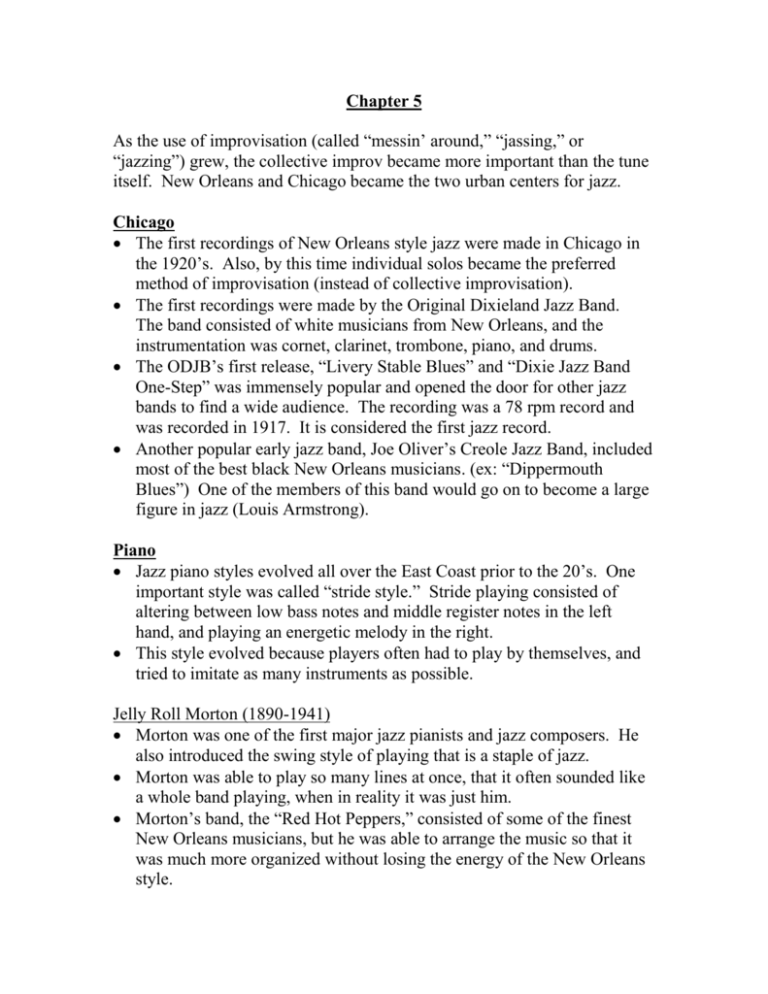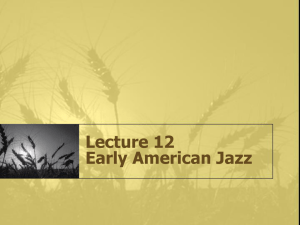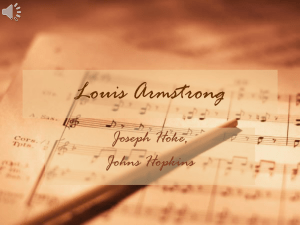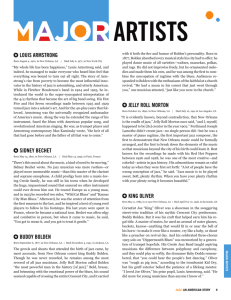Chapter 5 - WordPress.com
advertisement

Chapter 5 As the use of improvisation (called “messin’ around,” “jassing,” or “jazzing”) grew, the collective improv became more important than the tune itself. New Orleans and Chicago became the two urban centers for jazz. Chicago The first recordings of New Orleans style jazz were made in Chicago in the 1920’s. Also, by this time individual solos became the preferred method of improvisation (instead of collective improvisation). The first recordings were made by the Original Dixieland Jazz Band. The band consisted of white musicians from New Orleans, and the instrumentation was cornet, clarinet, trombone, piano, and drums. The ODJB’s first release, “Livery Stable Blues” and “Dixie Jazz Band One-Step” was immensely popular and opened the door for other jazz bands to find a wide audience. The recording was a 78 rpm record and was recorded in 1917. It is considered the first jazz record. Another popular early jazz band, Joe Oliver’s Creole Jazz Band, included most of the best black New Orleans musicians. (ex: “Dippermouth Blues”) One of the members of this band would go on to become a large figure in jazz (Louis Armstrong). Piano Jazz piano styles evolved all over the East Coast prior to the 20’s. One important style was called “stride style.” Stride playing consisted of altering between low bass notes and middle register notes in the left hand, and playing an energetic melody in the right. This style evolved because players often had to play by themselves, and tried to imitate as many instruments as possible. Jelly Roll Morton (1890-1941) Morton was one of the first major jazz pianists and jazz composers. He also introduced the swing style of playing that is a staple of jazz. Morton was able to play so many lines at once, that it often sounded like a whole band playing, when in reality it was just him. Morton’s band, the “Red Hot Peppers,” consisted of some of the finest New Orleans musicians, but he was able to arrange the music so that it was much more organized without losing the energy of the New Orleans style. Ex: “Wolverine Blues,” (early stride style) Ex: “Black Bottom Stomp” (early arrangement) Earl Hines (1903-1983) Hines was known for a roughness in his sound, created by striking the piano keys extremely hard. He is known to have broken the bass strings on several pianos, which is nearly impossible. His playing is sometimes referred to as “trumpet-style,” because the lines resemble more of what a trumpet would play than a piano. This opened the door for future pianists to experiment with less characteristic styles. Ex: “West End Blues” Hines was also known for his rhythmic proficiency and abruptly shifting solos. Ex: “Weather Bird” Fats Waller (1904-1943) Waller played with a bouncier, lighter stride feeling, and wrote many famous tunes, the most famous being “Ain’t Misbehavin.’” His more lyrical style was an inspiration to Count Basie, Dave Brubeck, and Art Tatum. Waller’s style was seen as more refined. Boogie Woogie In the South, a piano style that became called “Boogie Woogie” grew out of a specific left hand pattern. Boogie woogie became one of the major precursors to rock and roll. Ex: “Pine Top’s Boogie Woogie” James P. Johnson (1894-1955) Johnson was the most famous of the stride players. He was also part of an East coast jazz tradition, being born in New Jersey. His playing was fluid, and he was a key figure in bridging ragtime and jazz. He won many informal piano contests, and was said to have an orchestral approach to playing the piano. Outside of jazz, Johnson made many important contributions to music. He wrote 230 popular tunes, 19 symphonic works, and 11 musicals. Ex: “Carolina Shout” (written 1914, recorded 1921) (smoothness of stride style) Ex: “You’ve Got to be Modernistic” (orchestral playing) Trumpet Louis Armstrong (1901-1971) Known as the “father of jazz,” Armstrong was one of the first epic figures in jazz. Known as “Pops,” “Dippermouth,” and “Satchmo” (the latter two being jokes about his large mouth). His most innovative recordings were made in 1927-28, known as the “Hot Five” or “Hot Seven” recordings. Armstrong was not only known for his innovative soloing on the trumpet, but for his vocal tunes as well (After a series of health problems, his doctors told him not to play the trumpet, so he would sing at shows when his doctors were present and play when they were not). Armstrong’s Important Contributions: 1) Armstrong proved that individual solos could be as effective as group improvisation. 2) He relaxed the feel of ragtime, using what are now known as “swing rhythms.” 3) Armstrong was able to construct solos that were well-formed overall, suggesting a large structure, yet still sounded spontaneous. 4) He paced his solos to attain maximum drama. 5) Instead of embellishing the melody, Armstrong improvised new melodies that worked over a tune’s chord progressions. 6) Armstrong had an unusually strong command of the trumpet, which was not typical in jazz of the time. 7) He popularized the New Orleans style and then developed it further. 8) Armstrong popularized scat singing. Ex: “Wild Man Blues” Ex: “What a Wonderful World” Bix Beiderbecke (1903-1931) Beiderbecke was a white trumpeter from Iowa, and gave an alternative to the style of Louis Armstrong. He was a creative force, but did not have quite the command of his instrument that Armstrong had. His sound was cooler and more subtle, and his note choices were more unusual than Armstrong’s. Ex: “Singin’ the Blues” As a composer, he blended jazz with the sounds of French Impressionist composers Maurice Ravel and Claude Debussy. Ex: “In a Mist” Clarinet and Saxophone Frankie Trumbauer (1901-1956) One of the first jazz saxophonists, he is celebrated for his recordings with Bix Beiderbecke. Johnny Dodds (1892-1940) Dodds was known for playing with a raw, edgy sound, often relying on pitch bends and blue notes rather than fast notes. Ex: “Dippermouth Blues” (0:45) Sidney Bechet (1897-1959) Bechet, along with Louis Armstrong, turned jazz into a genre that relied more on solo improvisations. Although Bechet was able to play fast, exciting solos, he is more known for his note choices and pitch bends in slow tunes. Ex: “Blue Horizon” Ex: “Summertime” Trombone In ensemble improvisation, the trombone filled the low register between the bass and trumpet. In solo improvisation, the trombone tended toward a trumpet sound, but less complex and with more smears. Kid Ory (1886-1964) Kid Ory was one of the first famous trombonists. He played with a rough, powerful tone that complemented Louis Armstrong. Ex: “Struttin’ with Some Barbecue” Ex: “Muskrat Ramble” Jack Teagarden (1905-1964) Teagarden broke free from the rough sounds of the earlier trombonists, instead employing a fuller, richer sound. Ex: “Stars Fell on Alabama” Ex: “Dark Eyes” (rougher, but still full) Rhythm Section In early jazz, the rhythm section was not well-defined, nor was it as important as it would become in the swing era. Bass players often alternated between tuba and string bass, and drummers often played melodic lines rather than keeping time. On recordings, drummers were often not recorded due to the fragility of the recording equipment of the day. Blues Singers Bessie Smith (1894-1937) Known as the “Empress of the Blues,” Bessie Smith was known for her tremendously powerful and raw voice. The nuances of her voice were imitated by instrumentalists, which changed the way instrumentalists soloed. Ex: “St. Louis Blues” Ex: “Me and My Gin”







